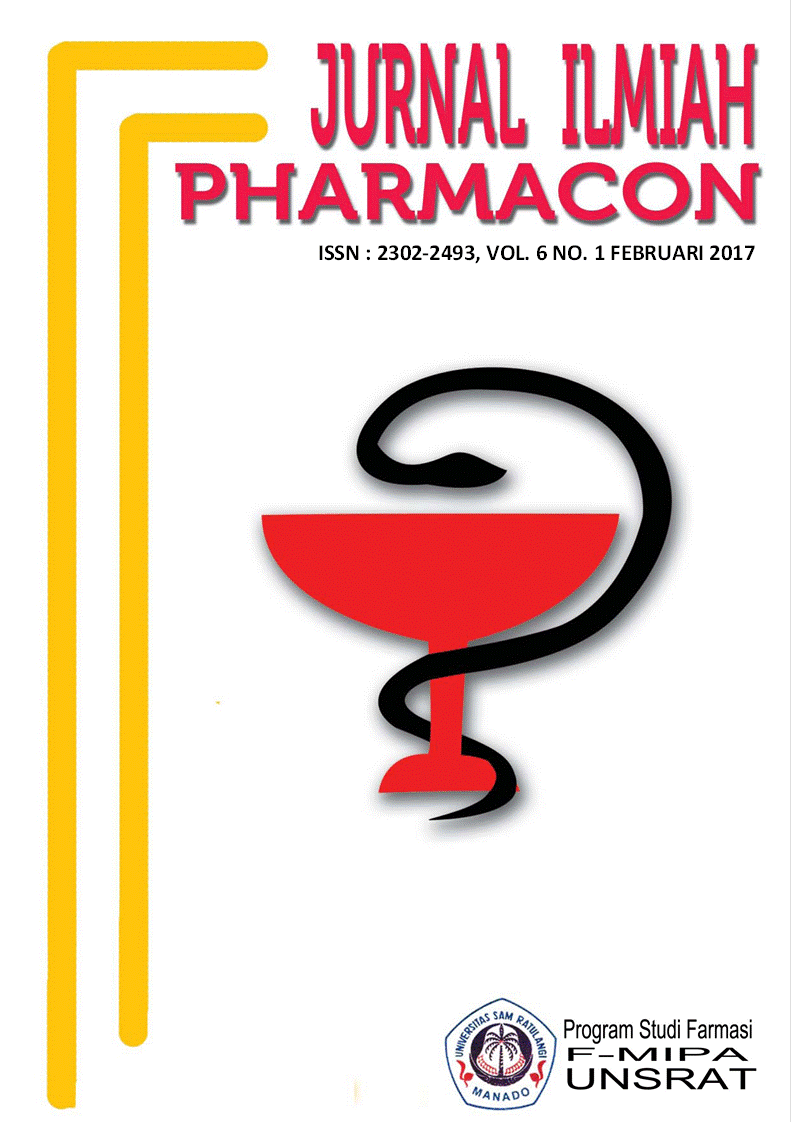UJI KONSENTRASI HAMBAT MINIMUM (KHM) PERASAN MURNI BAWANG PUTIH (Allium sativum) TERHADAP PERTUMBUHAN Candida albicans
DOI:
https://doi.org/10.35799/pha.6.2017.15000Abstract
UJI KONSENTRASI HAMBAT MINIMUM (KHM) PERASAN MURNI BAWANG PUTIH (Allium sativum) TERHADAP PERTUMBUHAN Candida albicans
Lumimuut Gloria Rambet1), Olivia Waworuntu1), Paulina N. Gunawan1)
1)Program Studi Pendidikan Dokter Gigi Fakultas Kedokteran UNSRAT Manado, 95115
2Bagian Mikrobiologi Fakultas Kedokteran UNSRAT Manado, 95115
Â
Â
ABSTRACT
Dental and oral hygiene that is less noticed can cause various diseases in the oral cavity. One cause of diseases of the oral cavity is by a fungi. Candida albicans is a type of pathogenic fungi from class of deuteromycota. This often occurs in denture users due to lack of awareness on oral hygiene care and for this reason, an increase of fungi colonies occurs causing inflammation around the denture stomatitis. Applying antifungal is one option, that is by using the juice of garlic (Aliium sativum). The purposes of this study is to determine and measure the Minimum Inhibitory Concentration (MIC) of pure garlic juice on the growth of Candida albicans. This study is a pure experimental research study with turbidimetry test and spectrophotometry. Garlic that has been cleaned, squeezed with a juicer, then pure juice is taken. Candida albicans is staken from the pure stock Laboratory Medical Faculty of Sam Ratulangi University. The result of this study shows that the minimum inhibitory concentration (MIC) of pure garlic (Allium sativum) on the growth of Candida albicans is the concentration of 50%.
Keywords: Garlic (Allium Sativum), Minimum Inhibitory Concentration (MIC), Candida albicans
ABSTRAK
Kebersihan gigi dan mulut yang kurang diperhatikan dapat menyebabkan berbagai penyakit dalam rongga mulut. Salah satu penyakit rongga mulut disebabkan oleh jamur. Candida albicans merupakan jenis jamur pathogen dari golongan deuteromycota. Sering terjadi pada pengguna gigi tiruan karena kurangnya kesadaran untuk merawat kebersihan rongga mulut membuat koloni jamur meningkat sehingga menyebabkan peradangan disekitar gigi tiruan yang dikenal dengan istilah denture stomatitis. Pemberian antifungi merupakan salah satu pilihan, yaitu dengan menggunakan perasan bawang putih (Allium sativum). Tujuan penelitian ini untuk mengetahui dan mengukur Konsentrasi Hambat Minimum (KHM) perasan murni bawang putih terhadap pertumbuhan Candida albicans. Penelitian ini merupakan penelitian eksperimental murni dengan rancangan penelitian Randomized Pretest-Postest control group design. Metode yang digunakan dalam penelitian ini yaitu metode serial dilusi dengan metode pengujian turbidimetri dan spektrofotometri. Bawang putih yang telah dibersihkan, diperas menggunakan juicer kemudian diambil perasan murni. Candida albicans diambil dari stok jamur murni Laboratorium Mikrobiologi Fakultas Kedokteran Universitas Sam Ratulangi. Hasil penelitian menunjukkan konsentrasi hambat minimum (KHM) perasan murni bawang pputih (Allium sativum) terhadap pertumbuhan Candida albicans didapat pada konsentrasi 50%.
Kata kunci: Bawang putih (Allium sativum), Konsentrasi Hambat Minimum (KHM), Candida albicans
Â
Downloads
Published
How to Cite
Issue
Section
License
Authors who publish with this journal agree to the following terms:
- Authors retain copyright and grant the journal right of first publication with the work simultaneously licensed under a Creative Commons Attribution-NonCommercial 4.0 International License that allows others to share the work with an acknowledgement of the work's authorship and initial publication in this journal.
- Authors are permitted and encouraged to post their work online (e.g., in institutional repositories or on their website) prior to and during the submission process, as it can lead to productive exchanges, as well as earlier and greater citation of published work (See The Effect of Open Access)










